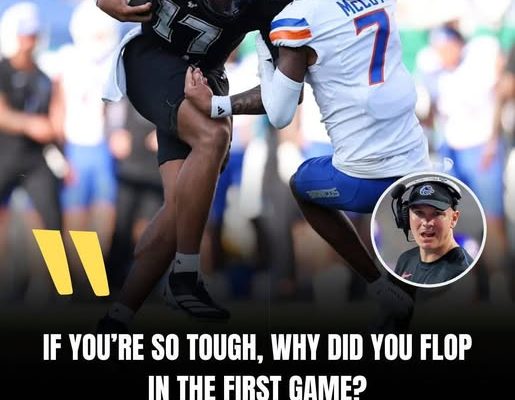College football has always been a sport where perception matters just as much as results. A team can put up gaudy numbers, completely overwhelm an opponent, and yet still face critics who insist that the win doesn’t count for much because of the name on the other sideline. That’s exactly the situation Boise State finds itself in after its Week 2 demolition of Eastern Washington. The Broncos cruised to a 51–14 victory, showing off their speed, depth, and ability to impose their will for four quarters. It was the type of dominant performance fans expect from a program that has made a reputation for overachieving on the national stage. Yet instead of celebrating, the national conversation has tilted toward skepticism. Analysts lined up to dismiss the win with a familiar refrain: “Do it against a real school.”
It’s a tired argument, but it continues to surface every time a Group of Five team delivers a statement performance against an FCS opponent. For Boise State, this particular criticism cuts deeper because the program has long been a thorn in the side of established powerhouses. They’re not new to this stage; they’ve been here before. Think back to the iconic Fiesta Bowl win over Oklahoma, the years where they were consistently ranked in the top 10, and the seasons when they dominated the Mountain West Conference. Boise State isn’t some upstart still proving its worth. It’s a program with decades of credibility, and yet it finds itself lumped into the same dismissive conversations that brush off their wins as meaningless until they beat a blue blood like Penn State, Michigan, or Alabama.
But here’s the irony—when teams like Penn State schedule these very same FCS opponents, blow them out, and rack up the same kind of lopsided scores, the narrative somehow shifts. Suddenly it’s about how sharp the starting quarterback looked, how the offensive line gelled, or how the defense showed elite depth. The skepticism vanishes when the helmet logo belongs to a Big Ten or SEC powerhouse. That double standard is what fuels frustration among fans of programs like Boise State. Wins against FCS teams don’t move the needle in national rankings or perception, but the way they’re interpreted depends heavily on who is doing the winning.
Of course, nobody is saying Eastern Washington is Penn State. The Eagles are an FCS team for a reason, and their roster depth, facilities, and recruiting reach are nowhere near what Boise State has. But Eastern Washington isn’t a pushover either. This is a program with a national championship at the FCS level, multiple playoff appearances, and a history of producing NFL talent. They’ve knocked off FBS teams in the past, and they’re known for having a creative offense that can make defenses pay if they aren’t locked in. Beating them soundly isn’t something you just shrug off, especially when the score is as lopsided as 51–14. Boise State didn’t just survive; they dominated from start to finish, and that’s worth acknowledging regardless of the opponent’s classification.
Still, the critics say, “do it against Penn State.” That phrase has almost become a catch-all challenge in college football discourse. Beat up on smaller schools all you want, but until you prove yourself against the heavyweights, the narrative won’t change. And to an extent, there’s some truth in that. College football is built around measuring sticks, and Boise State knows that better than anyone. Their program’s reputation was built on upsetting giants. They didn’t earn national respect by beating FCS schools; they earned it by knocking off top-10 teams in bowl games and scheduling tough non-conference opponents. That’s why the skepticism around this win stings. Boise State understands the rules of the game, but it feels like the bar keeps moving whenever it suits the narrative.
There’s also something to be said about how unfair it is to reduce players’ efforts to nothing more than the opponent’s label. The athletes on Boise State’s roster spent months preparing for this game, training, lifting, grinding through practices, and studying film. They executed at a high level, put up over 500 yards of offense, and held Eastern Washington to just 14 points. To dismiss that as “meaningless” because the other team happens to play in the FCS is to ignore the skill, discipline, and execution that went into it. The score wasn’t close. There were no fluky plays, no late rallies to pad the margin. It was dominance, pure and simple. That should count for something, even if it wasn’t against Penn State.
And yet, there’s no denying that the road to respect for programs like Boise State is tougher than it should be. Every win against an FCS team is seen as empty calories, every stumble against a Power Five opponent is magnified, and every great season comes with the asterisk of “yeah, but look at their schedule.” That’s why the Penn State challenge resonates. Beating a team of that caliber, one that plays in front of 100,000 fans at Beaver Stadium, one that consistently produces NFL draft picks, is seen as the ultimate test. Do that, and suddenly all the questions vanish. The same people who dismiss the Eastern Washington win will be the first to crown Boise State as “for real” if they upset a top Big Ten team.
But should that really be the standard? Should a program’s legitimacy hinge entirely on a handful of games against the so-called elites? College football’s structure practically ensures that not every program will have those opportunities. Schedules are locked years in advance, conference politics play a massive role, and the Power Five schools often avoid scheduling dangerous Group of Five teams for fear of embarrassment. Boise State has tried to line up those marquee games, but they don’t come around every season. In the meantime, should the team’s actual performances be dismissed simply because the opponent doesn’t wear a Big Ten logo?
There’s also the fan perspective to consider. For Boise State supporters, this win was a chance to enjoy football the way it’s meant to be enjoyed. It was a showcase of the team’s depth, with backups getting meaningful snaps. It was a reminder of what this program can do when it’s firing on all cylinders. For recruits watching at home, it was proof that Boise State remains a place where you can join a winning culture and showcase your skills in a dominant system. Those storylines matter, even if national analysts shrug them off.
And if we’re being honest, isn’t that what college football is supposed to be about? The joy of the game, the pride of representing your school, and the memories made on Saturdays? Not every game has to be a clash of titans to matter. Not every win has to be against Penn State to be valid. Sometimes a 51–14 win is exactly what it looks like: a well-prepared team going out and executing at a high level, showing flashes of brilliance, and giving its fans a reason to cheer.
That said, the “do it against Penn State” crowd won’t go away anytime soon. And in some ways, that’s the challenge Boise State should embrace. If they want to climb back into the national conversation, these are the games they’ll eventually need to win. They’ve done it before, and there’s no reason to think they can’t do it again. But in the meantime, dismissing their wins outright is a disservice not only to the program but to the sport as a whole.
So here’s the real question for fans: how much should dominance matter, regardless of opponent? Should a 51–14 win be taken at face value as a sign of strength, or should it always come with an asterisk unless it’s against Penn State or another top-tier program? And where do we draw the line? If Penn State beats Delaware by 50, it’s validation. If Boise State does the same against Eastern Washington, it’s meaningless. Why the double standard?
That’s where I’d like to hear from you. Do you think Boise State’s win deserves more credit than it’s getting? Or do you agree with the critics who say it proves nothing until they beat a powerhouse? Drop your thoughts in the comments, debate with other fans, and let’s have a real conversation about what wins should mean in today’s college football landscape. Because at the end of the day, every Saturday matters to the players, the coaches, and the fans who live and breathe this sport. Maybe it’s time the national conversation caught up.



